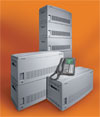 The Strata CTX-100 and CTX-670 are complete business communication
solutions with enhanced voice mail integration, including a choice of two new Toshiba voice processing solutions, and the ability to network multiple locations.
The Strata CTX-100 and CTX-670 are complete business communication
solutions with enhanced voice mail integration, including a choice of two new Toshiba voice processing solutions, and the ability to network multiple locations. New Systems With New Technology
The Strata CTX100 and Strata CTX670 are Toshiba's new generation business communication systems utilizing the latest digital technology to provide configuration flexibility and optimum performance, while minimizing future obsolescence. The Strata CTX platform is based on a high-speed, 70 MIPS, 32-bit RISC processor, Dynamic Random Access Memory (DRAM),
Static Random Access Memory (SRAM) with a lithium battery for back-up memory, and Flash ROM program memory. The primary architectural features include:
- Flash ROM that provides program memory, making future software upgrades easy because there's no need to replace the memory chip hardware. Updates can be implemented on-site or remotely.
- New architecture that takes advantage of a high-speed backplane that provides faster I/O functions and greater port density in a compact, cost-effective, modular design.
- Digital PAD technology that is used to compensate for differing transmission levels between internal and external devices, delivering consistently clear sound which is especially useful for conference calls. This is controlled and set in programming; no additional hardware is required.
- Feature options that are software controlled and do not require additional DSP hardware to allocate feature resources, providing flexibility and cost savings.
- One processor model that supports all Strata CTX670 configurations, from smallest to largest, accommodating affordable price points and cost-effective growth in both small and large configurations. The Strata CTX100 uses the same cost-effective single processor design.
Strata Net Enables Multiple Networked Strata CTX Systems
Utilizing Strata Net, a multi-system private networking application based on QSIG (an international standard for the interconnection of PBXs), users can network multiple Strata CTX670 and/or CTX100 systems, allowing them to operate with a high level of transparency.
Strata Net enables transparent dialing, with simple feature operation, through a coordinated numbering plan. This allows users to call each other across network nodes with simple network directory numbers and eliminates the need for access codes and network maps.
Strata Net also provides the ability to implement centralized voice mail, enabling a single voice mail system to serve all users throughout the enterprise network. Strata Net also facilitates centralized attendant service, which means that calls to all system nodes can be answered by a single attendant or attendant group, regardless of where the extensions or trunks are physically located. In addition, users need only dial "0" to reach the attendant, regardless of the network node on which they reside.
Voice Mail Integration for a Complete Turnkey Solution
The Strata CTX products are designed for advanced integration with Toshiba's new voice processing solutions, Stratagy ES Release 3 and Stratagy IVP8, as well as the new Stratagy ES platform, Model C1. All of the new Stratagy voice processing solutions provide improved integration between both Strata CTX systems to deliver features such as Call Record to
Voice Mail.
Additionally, Stratagy ES systems can display many voice processing functions when used with the new Toshiba 3000-series digital LCD telePBXs. Using soft keys on the digital telePBX LCD, users can easily operate certain features, such as Play, Reply, Pause, and Delete. Voice prompts still play over the handset should the user
prefer to use them.
Simple, Cost-Effective Upgrade Path to CTX From Toshiba Strata DK Systems
The new CTX products are replacing Toshiba's current DK40i and DK424i product lines, but with Toshiba's investment protection strategy, customers can cost-effectively migrate to the new products.
Current users of Toshiba Strata DK424i telePBX systems can easily and economically migrate to the Strata CTX670 by continuing to use most of their system components, including the base cabinet, expansion cabinets, trunk and station cards, and telePBXs. All that is needed is a new Strata CTX670 processor and reprogramming of the system.
Similarly, current users of Toshiba Strata DK40i telePBX systems can cost-effectively migrate to the Strata CTX100 or Strata CTX670 by continuing to use their digital telePBXs, as well as some CO line and station cards.
Room to Grow by Simply Adding to Existing Equipment
The design of Strata CTX systems minimizes cost of ownership. The modular architecture enables customers to expand by adding, not replacing, common equipment. For example, cost-effective growth from smallest to largest configurations can be achieved using the same processor and adding licenses and interface cards.
Strata CTX100 customers also have the option of migrating to the CTX670 when their needs exceed the capabilities of the smaller system. Their digital telePBXs, and most CO line and station cards, can be reused in the larger CTX670 system, thus taking advantage of Toshiba's investment protection strategy.
 New 3000-Series Digital TelePBXs
New 3000-Series Digital TelePBXs
Toshiba's new 3000-Series Digital TelePBXs offer contemporary styling and incorporate several design improvements, six models are available to meet a variety of end-user needs. The 3000-series digital telePBXs are compatible with both the new Strata CTX systems and current Strata DK systems. Three models feature Liquid Crystal Displays (LCDs). The top
model has an extra large, 8-line by 24-character LCD, especially useful for feature prompting and directory dialing.